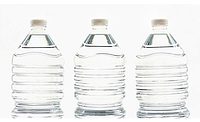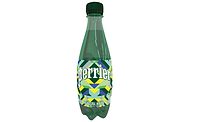On-Demand Bottled Water
By MEGAN WAITKOFF
Production technology keeps Safeway’s bottled water line flowing
Despite the tranquility of the mountain valley surroundings, exciting things are happening indoors at Safeway’s grocery and bottled water plant in Merced, Calif.
The plant’s bottled water line is one of
Safeway’s more recent capital manufacturing investments.
“Every year, we’re raising the bar with
the technology of our equipment and the in-line inspections we have in
place,” says David Nelsen, vice president of manufacturing for
Safeway. “The goal is to reduce variability in the workplace in order
to improve quality and reduce costs.”
Production matters
This May, the plant
celebrated its 10-year anniversary, and employees took time to remember the
plant’s somewhat cluttered beginning. When the Merced location was
constructed, enough equipment for three plants was brought into one
facility during a consolidation effort. Employees originally ran two
production lines — one for grocery products and the other for peanut
butter.
The plant still operates two lines, each with an
enclosed filling area, but peanut butter production was replaced with a
blowmold operation in 2004. All of the rooms were scrubbed down for safety
reasons, water lines for spring and purified water were installed, and
employees were trained on the new equipment. But the lines were completely
switched within a week.
“It was due to creative scheduling,” says
Plant Manager Amalee Jayasinghe.
It also was credited to the motivation of the line
operators, says Michael Williams, plant superintendent. “Empowerment
of the employees is the utmost. Otherwise, we wouldn’t have seen the
successes we have,” he says.
Employee participation is promoted aggressively and
rewarded — the motto “Think like successful owners” is
spread across the production entryway as the Merced plant’s vision
statement. The vision is updated every year in November, when plant
employees meet to discuss production goals. Every employee receives a
credit-card sized copy of the plant's vision and key initiatives.
Line operators also participate in “Six-Minute
Meetings” at the beginning of every shift to review the previous
day’s activities, and on Wednesdays, they have pre-planning meetings
to develop the following week’s schedules and action plans.
“Seven by Seven” meetings (which refer to the plant’s 7
a.m. to 7 p.m. day) are held once every four weeks to discuss the prior
period’s performance on waste reduction, efficiency, quality and
productivity.
“When you start empowering people, you get a lot
of untapped talent that you would not normally get otherwise,”
Williams says. “Once we’re satisfied internally, our external
customers are satisfied.”
According to Nelsen, plant managers work to develop
their staff through a formalized, ongoing process. Individuals receive
feedback on a regular basis and personal development plans are established
on an annual basis. Individual employees and Safeway have benefited from
the process through performance improvements and by helping individuals
achieve their career aspirations. In addition, Safeway’s 31 plant
managers meet as a group on an annual basis to review each plant’s
key performance metrics along with the annual operating plan for the next
year.
“Providing coaching is really a win-win
situation, and it gives our employees the opportunity to sharpen the
saw,” Nelsen says.
To acknowledge outstanding achievements, Safeway
introduced plant awards to recognize improvements in the areas of safety,
quality, innovation and world-class manufacturing. Merced’s award
banners are hung in the warehouse area with the same pride that sports
teams hang their championship banners.
A friendly spirit of competition co-exists with
teamwork, both of which contribute to the plant’s production
excellence. The water line operators nicknamed themselves the Water Dogs,
and the grocery line employees are the Tomato Bullies. While the two teams
vie for internal rewards, they also play side by side on the
company-sponsored plant softball team.
Full bottle
The bottled water line doesn’t look a day older
than two weeks, thanks to the meticulous upkeep of its recently installed
equipment. The installment of the bottled water line was a two-phase
process.
Safeway first had to install
the water lines. Twenty-five percent of the production is spring water,
which is sourced from Baxter, Calif. (about 180 miles away), and the rest
is purified drinking water. In the first phase, the plant used stock
plastic bottles from a supplier, which cost roughly $8,000 a day, Williams
says.
In the second phase a year later, a blowmolder was
installed, and the plant now produces what it needs on-demand.
The Merced plant handles bottled water production for
all of Safeway’s brands, so efficiency is a necessity. The plant
produces 0.5-, 1- and 1.5-liter bottles, and change parts along the line
are color-coded for changeover efficiency. For example, orange is for the
0.5-liter, yellow for 1-liter and green for 1.5-liters. “One-Point
Lessons” also were developed for quick changeovers; pictures are
posted with arrows that point to the parts that need to be changed, rather
than having employees read a lengthy document.
The bottled water line starts with bottle
manufacturing. Seventy-two totes of polyethylene terephthalate (PET)
preform vials (19,800 to be exact) are held in a temperature-controlled
room where they cure for 48 to 72 hours. They are then fed to a blowmolder.
To learn the new machine, Jayasinghe, Plant Engineer Tony Delgado and lead
operators were sent to Germany for a week of training and did factory
acceptance tests on their own machine.
The preforms are heated to 67° C, 230 at a time,
for two and a half seconds. The stretch blowmolder pushes down the preforms
and blows the walls against the bottlemold. The 500-ml. bottles are blown
with a decorative pattern just below the neck.
“Everyone thinks, ‘Oh, what a pretty
design,’ but it really serves a purpose,” Jayasinghe says.
“It’s all about panel strength.”
As the bottles are being blown, quality checks are
performed by an operator once an hour. Pictures are posted in the quality
control area that show the visual characteristics the operator should look
for, such as puddling, haze and cocked necks. The plant uses the same
pictures as the preform supplier to improve communication. “We wanted
to make sure we spoke the same language,” Jayasinghe says.
The formed bottles are then accumulated and passed
through at roughly 300 feet per minute. An air-driven conveyor moves them
along a 200-foot path overhead to a 60-valve rotary filler. This filler is
a self-contained positive air enclosure that includes a bottle rinser and a
15-head capper.
After the bottles are filled, it’s off to the
packaging area for the remainder of both the bottled water and grocery
lines. The labeler applies label stock to the bottles at 615 bottles per
minute, and a coder marks the necessary tracking information. A lane
separator then divides the proper number of bottles, which are packed into
trays and shrinkwrapped.
The trays then travel to the next room to be
palletized and are live loaded for shipment. All trailers are held on the
lot for 24 hours. The plant handles 135,000 cases of water per week, adding
up to more than five million cases per year.
The automated line has five operators. And while they
always have their eyes and ears open to check for quality, some 50 vision
sensors oversee all packaging operations.
For quality assurance, at least one bottle of each
batch is kept at the Merced plant for the duration of the two-year shelf
life. Samples also are collected each week and sent to an independent lab
for quality checks.
Secondary packaging
The plant uses two palletizers, one dedicated to each
line, to package the cases of bottled water and grocery products. Vision
sensors make sure the lids and bottle caps are on properly and the trays
are oriented correctly. For the bottled water line, the palletizer creates
one pallet (72 cases) every minute; for the grocery line, it’s one
pallet every four minutes. Some 41,000 cases are packed in two 10-hour
shifts.
Two line support drivers are the only operators in the
distribution area. A laminated sheet with 13 different codes based on the
package type is posted near the computer controller for automatic and
pre-programmed changeovers.
“It’s just a matter of pressing a button
and clearing the line out,” Williams says. “It takes 30
seconds.”
After the trays are palletized, an operator uses a
standup forklift to move the pallets to the six storage levels in the
warehouse. The storage area can hold 2,500 pallets at capacity. Bottled
water is stored at Merced for at least 24 hours. During filling, ozone is
added to the water for sterilization, but it has to dissipate before the
water is drinkable. The process takes 12 hours; Safeway doubles it to be
safe.
When the pallets are slated for distribution,
they’re loaded onto trucks in one of nine loading bays. Seventeen
truckloads of water are distributed per day; 30 truckloads of overall
product per day.
Quality controlled
Quality checks don’t start at the Safeway plant;
they start with its suppliers. To achieve Quality Assurance vendor
approval, packaging manufacturers have to:
• Complete a pre-audit questionnaire
• Submit samples for approval
• Receive a third-party
audit (Grocery Manufacturers Association, Safe audit or equivalent)
for food or pass an internal audit
• Have first production samples approved
• Receive ongoing sample evaluations
At a glance
Safeway
Location: Merced, Calif.
Plant size: 133,000 square feet
Employees: 72
Product lines: Bottled water, salsa, pasta, jelly and
preserves
Package types: Glass jars, plastic bulk containers and
PET bottles
Number of packaging lines: 2





